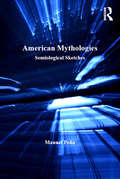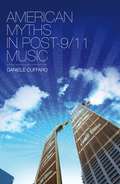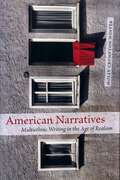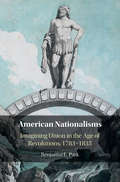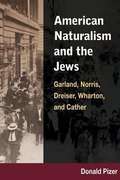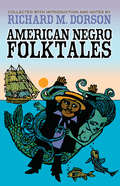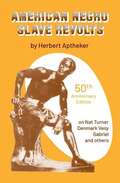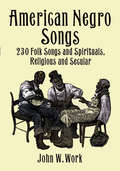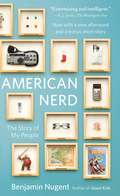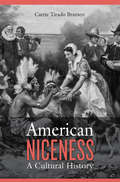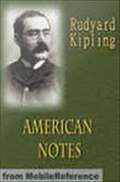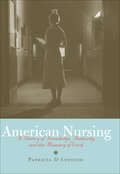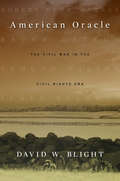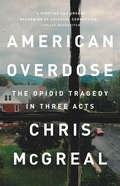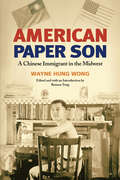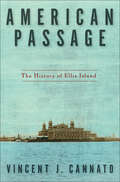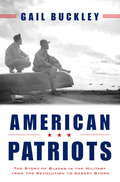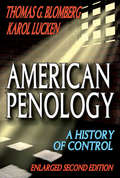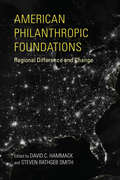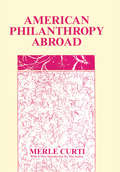- Table View
- List View
American Mythologies: Semiological Sketches
by Manuel PeñaAmerican Mythologies examines eleven myths that form part of the storehouse of present-day American mythologies, elucidating the nature of contemporary myths by investigating their ideological sub-terrain. Grounded in a semiological approach, which explores the displacement of information and the transformation of signs that characterise mythic communication, this book sheds light on the socio-economic, gendered, national and racial interests that lie behind myth-making. Presenting rich case studies from popular culture and public discourse, it demonstrates the manner in which these myths, and American mythology in general, promote the core values of everyday life under capitalism: rugged individualism, the unfettered right to accumulate wealth, the superior moral character of free-enterprise democracy, and its abundant opportunities for every citizen. By the same token, that same mythology negates the corruption endemic to the capitalist social order, an order that also promotes inescapable class, racial, and gender inequalities which confine the majority of Americans to a life of constant economic struggle. A fresh critique of the foundations of American culture, American Mythologies will appeal to those with interests in sociology, social and cultural theory, and cultural and media studies.
American Mythos: Why Our Best Efforts to Be a Better Nation Fall Short
by Robert WuthnowAmerica was built on stories: tales of grateful immigrants arriving at Ellis Island, Horatio Alger-style transformations, self-made men, and the Protestant work ethic. In this new book, renowned sociologist Robert Wuthnow examines these most American of stories--narratives about individualism, immigration, success, religion, and ethnicity--through the eyes of recent immigrants. In doing so, he demonstrates how the "American mythos" has both legitimized American society and prevented it from fully realizing its ideals. This magisterial work is a reflection and meditation on the national consciousness. It details how Americans have traditionally relied on narratives to address what it means to be strong, morally responsible individuals and to explain why some people are more successful than others--in short, to help us make sense of our lives. But it argues that these narratives have done little to help us confront new challenges. We pass laws to end racial discrimination, yet lack the resolve to create a more equitable society. We welcome the idea of pluralism in religion and values, yet we are shaken by the difficulties immigration presents. We champion prosperity for all, but live in a country where families are still homeless. American Mythos aptly documents this disconnect between the stories we tell and the reality we face. Examining how cultural narratives may not, and often do not, reflect the reality of today's society, it challenges readers to become more reflective about what it means to live up to the American ideal.
American Myths in Post-9/11 Music
by Daniele CuffaroAfter September 11, 2001, the void left following the attack on the Twin Towers in the heart of New York was the visible symbol that there was to be a breaking point with the past. The attacks dramatically changed the everyday lives of the American people and the new devastating landscape led people to seek to restore the certainties that had been so suddenly shattered. In doing this, Americans went back to the historical myths in their culture. This book explores the collective memory and historical American myths like, for example, the myth of the innocent nation and the frontier myth, and shows how some of these nationally considered historical truths have not disappeared, but were indeed exhumed in the music produced post-9/11.
American Narratives: Multiethnic Writing in the Age of Realism
by Margaret Crumpton WinterAmerican Narratives takes readers back to the turn of the twentieth century to reintroduce four writers of varying ethnic backgrounds whose works were mostly ignored by critics of their day. With the skill of a literary detective, Molly Crumpton Winter recovers an early multicultural discourse on assimilation and national belonging that has been largely overlooked by literary scholars. At the heart of the book are close readings of works by four nearly forgotten artists from 1890 to 1915, the era often termed the age of realism: Mary Antin, a Jewish American immigrant from Russia; Zitkala- a, a Sioux woman originally from South Dakota; Sutton E. Griggs, an African American from the South; and Sui Sin Far, a biracial, Chinese American female writer who lived on the West Coast. Winter's treatment of Antin's The Promised Land serves as an occasion for a reexamination of the concept of assimilation in American literature, and the chapter on Zitkala- a is the most comprehensive analysis of her narratives to date. Winter argues persuasively that Griggs should have long been a more visible presence in American literary history, and the exploration of Sui Sin Far reveals her to be the embodiment of the varied and unpredictable ways that diversity of cultures came together in America.In American Narratives, Winter maintains that the writings of these four rediscovered authors, with their emphasis on issues of ethnicity, identity, and nationality, fit squarely in the American realist tradition. She also establishes a multiethnic dialogue among these writers, demonstrating ways in which cultural identity and national belonging are peristently contested in this literature.
American Nationalisms
by Benjamin E. ParkAmerica was born in an age of political revolution throughout the Atlantic world, a period when the very definition of 'nation' was transforming. Benjamin E. Park traces how Americans imagined novel forms of nationality during the country's first five decades within the context of European discussions taking place at the same time. Focusing on three case studies - Massachusetts, Pennsylvania, and South Carolina - Park examines the developing practices of nationalism in three specific contexts. He argues for a more elastic connection between nationalism and the nation-state by demonstrating that ideas concerning political and cultural allegiance to a federal body developed in different ways and at different rates throughout the nation. American Nationalisms explores how ideas of nationality permeated political disputes, religious revivals, patriotic festivals, slavery debates, and even literature.
American Naturalism and the Jews: Garland, Norris, Dreiser, Wharton, and Cather
by Donald PizerAmerican Naturalism and the Jews examines the unabashed anti-Semitism of five notable American naturalist novelists otherwise known for their progressive social values. Hamlin Garland, Frank Norris, and Theodore Dreiser all pushed for social improvements for the poor and oppressed, while Edith Wharton and Willa Cather both advanced the public status of women. But they all also expressed strong prejudices against the Jewish race and faith throughout their fiction, essays, letters, and other writings, producing a contradiction in American literary history that has stymied scholars and, until now, gone largely unexamined. In this breakthrough study, Donald Pizer confronts this disconcerting strain of anti-Semitism pervading American letters and culture, illustrating how easily prejudice can coexist with even the most progressive ideals. Pizer shows how these writers' racist impulses represented more than just personal biases, but resonated with larger social and ideological movements within American culture. Anti-Semitic sentiment motivated such various movements as the western farmers' populist revolt and the East Coast patricians' revulsion against immigration, both of which Pizer discusses here. This antagonism toward Jews and other non-Anglo-Saxon ethnicities intersected not only with these authors' social reform agendas but also with their literary method of representing the overpowering forces of heredity, social or natural environment, and savage instinct.
American Negro Folktales
by Richard M. DorsonA preacher battles a bear, a mother returns from the dead, and a clever servant conducts a Big Feet Contest in this rich anthology of African-American folklore. Scores of humorous and harrowing stories, collected during the mid-twentieth century, tell of talking animals, ghosts, devils, and saints.The first part of the book provides a setting for the fables, in which folklorist Richard M. Dorson discusses their origins and the artistry of storytellers. The second part consists of the tales, which include the adventures of Old Marster and John, supernatural episodes, and comical and satirical anecdotes as well as more realistic accounts of racial injustice. Recounted in the actual words of the narrators, the folktales abound in bold language, memorable imagery, and bittersweet humor that reflect the essence of African-American storytelling traditions.
American Negro Slave Revolts
by Herbert ApthekerYears ago, the controlling view held that the response of the slaves in the United States to their bondage "was one of passivity and docility". That opinion, so decisive a part of the chauvinism afflicting the nation, is shown to be false in this book and in the material accumulated since its initial appearance has further substantiated this thesis; namely, that the African-American people, in slavery, forged a record of discontent and of resistance comparable to that marking the history of any other oppressed people.
American Negro Slavery: A Survey of the Supply, Employment, and Control of Negro Labor as Determined by the Plantation Regime
by Ulrich Bonnell PhillipsOriginally published in 1918, Ulrich Bonnell Phillips?s American Negro Slavery was widely hailed upon publication as the most comprehensive and accurate examination of enslaved Africans in the South by an academic historian. In the 1950s, however, a new generation of historians?led by Kenneth Stamp?challenged many of Phillips?s inaccurate and racist views about slavery. While many historians today acknowledge that American Negro Slavery is a pioneering work, most agree that Phillips?s misunderstandings, misinterpretations, and overt racism profoundly diminish his conclusions. This 1966 edition includes a foreword by Eugene D. Genovese, author of numerous academic works on slavery, including the Bancroft Prize-winning Roll, Jordan, Roll: The World the Slaves Made (1974).
American Negro Songs: 230 Folk Songs and Spirituals, Religious and Secular
by John W. WorkFrom joyous gospel to deeply felt blues, this wonderful collection contains vintage songs sung and played through the years by black Americans — at work, in church, and for pure entertainment. Included are spirituals, blues, work songs, and a variety of social and dance songs.This important volume was originally compiled in 1940 by Dr. John W. Work, the noted musicologist affiliated with Fisk University and the celebrated Fisk Jubilee Singers. In it, he discusses the origins and history of black American folk music, the influence of slavery and African cultures, and the lyric significance of such much-loved songs as "Swing Low, Sweet Chariot," Steal Away to Jesus," "Lord, I Want to Be a Christian," and "John Henry." These informative notes lead up to the heart of the book: the complete words and music for 230 religious and secular songs, including "Study War No More," "Keep Me from Sinking Down," "You May Bury Me in the East," "Rock of Ages," "Go Tell It on the Mountain," and many others.This is an indispensable treasury of music for singers, musicians and all readers seeking a comprehensive sourcebook of black American folk music. It will be equally welcomed at parties, family get-togethers, sing-alongs, church events, and other gatherings where people want to play and sing these classic folk songs that are an integral part of American musical history.
American Nerd: The Story of My People
by Benjamin NugentMost people know a nerd when they see one but can't define just what a nerd is. American Nerd: The Story of My People gives us the history of the concept of nerdiness and of the subcultures we consider nerdy. What makes Dr. Frankenstein the archetypal nerd? Where did the modern jock come from? When and how did being a self-described nerd become trendy? As the nerd emerged, vaguely formed, in the nineteenth century, and popped up again and again in college humor journals and sketch comedy, our culture obsessed over the designation. Mixing research and reportage with autobiography, critically acclaimed writer Benjamin Nugent embarks on a fact-finding mission of the most entertaining variety. He seeks the best definition of nerd and illuminates the common ground between nerd subcultures that might seem unrelated: high-school debate team kids and ham radio enthusiasts, medieval reenactors and pro-circuit Halo players. Why do the same people who like to work with computers also enjoy playing Dungeons & Dragons? How are those activities similar? This clever, enlightening book will appeal to the nerd (and antinerd) that lives inside all of us.
American Niceness: A Cultural History
by Carrie Tirado BramenThe cliché of the Ugly American—loud, vulgar, materialistic, chauvinistic—still expresses what people around the world dislike about their Yankee counterparts. Carrie Tirado Bramen recovers the history of a different national archetype—the nice American—which has been central to ideas of American identity since the nineteenth century.
American Nightmare: The History of Jim Crow
by Jerrold M. Packard“A very powerful and unsettling story of our nation’s century-long ‘pogrom’ by vengeful white Southerners against their black neighbors.” —The Washington TimesFor a hundred years after the end of the Civil War, a quarter of all Americans lived under a system of legalized segregation called Jim Crow. Together with its rigidly enforced canon of racial “etiquette,” these rules governed nearly every aspect of life—and outlined draconian punishments for infractions.The purpose of Jim Crow was to keep African Americans subjugated at a level as close as possible to their former slave status. Exceeding even South Africa’s notorious apartheid in the humiliation, degradation, and suffering it brought, Jim Crow left scars on the American psyche that are still felt today. American Nightmare examines and explains Jim Crow from its beginnings to its end: how it came into being, how it was lived, how it was justified, and how, at long last, it was overcome only a few short decades ago. Most importantly, this book reveals how a nation founded on principles of equality and freedom came to enact as law a pervasive system of inequality and virtual slavery.Although America has finally consigned Jim Crow to the historical graveyard, Jerrold Packard shows why it is important that this scourge—and an understanding of how it happened—remain alive in the nation’s collective memory.“Sweeping history . . . Packard compels us to remember that one cannot effectively confront the challenges posed by contemporary race relations without recognizing the agonies of the American past.” —The Christian Science Monitor
American Notes
by Rudyard KiplingThis is what Bret Harte has written of the great city of San Francisco, and for the past fortnight I have been wondering what made him do it. There is neither serenity nor indifference to be found in these parts; and evil would it be for the continents whose wardship were intrusted to so reckless a guardian. Behold me pitched neck-and-crop from twenty days of the high seas into the whirl of California, deprived of any guidance, and left to draw my own conclusions. <P> <P> Protect me from the wrath of an outraged community if these letters be ever read by American eyes San Francisco is a mad city--inhabited for the most part by perfectly insane people, whose women are of a remarkable beauty. .
American Nursing: A History of Knowledge, Authority, and the Meaning of Work
by Patricia D'AntonioFirst Place, History and Public Policy, 2010 American Journal of Nursing Book of the Year AwardsThis new interpretation of the history of nursing in the United States captures the many ways women reframed the most traditional of all gender expectations—that of caring for the sick—to create new possibilities for themselves, to renegotiate the terms of some of their life experiences, and to reshape their own sense of worth and power. For much of modern U.S. history, nursing was informal, often uncompensated, and almost wholly the province of female family and community members. This began to change at the end of the nineteenth century when the prospect of formal training opened for women doors that had been previously closed. Nurses became respected professionals, and becoming a formally trained nurse granted women a range of new social choices and opportunities that eventually translated into economic mobility and stability. Patricia D'Antonio looks closely at this history—using a new analytic framework and a rich trove of archival sources—and finds complex, multiple meanings in the individual choices of women who elected a nursing career. New relationships and social and professional options empowered nurses in constructing consequential lives, supporting their families, and participating both in their communities and in the health care system. Narrating the experiences of nurses, D'Antonio captures the possibilities, power, and problems inherent in the different ways women defined their work and lived their lives. Scholars in the history of medicine, nursing, and public policy, those interested in the intersections of identity, work, gender, education, and race, and nurses will find this a provocative book.
American Oracle: The Civil War in the Civil Rights Era
by David W. Blight“The ghosts of the Civil War never leave us, as David Blight knows perhaps better than anyone, and in this superb book he masterfully unites two distant but inextricably bound events.”―Ken Burns Standing on the steps of the Lincoln Memorial on August 28, 1963, a century after the signing of the Emancipation Proclamation, Martin Luther King, Jr., declared, “One hundred years later, the Negro still is not free.” He delivered this speech just three years after the Virginia Civil War Commission published a guide proclaiming that “the Centennial is no time for finding fault or placing blame or fighting the issues all over again.” David Blight takes his readers back to the centennial celebration to determine how Americans then made sense of the suffering, loss, and liberation that had wracked the United States a century earlier. Amid cold war politics and civil rights protest, four of America’s most incisive writers explored the gulf between remembrance and reality. Robert Penn Warren, the southern-reared poet-novelist who recanted his support of segregation; Bruce Catton, the journalist and U.S. Navy officer who became a popular Civil War historian; Edmund Wilson, the century’s preeminent literary critic; and James Baldwin, the searing African-American essayist and activist—each exposed America’s triumphalist memory of the war. And each, in his own way, demanded a reckoning with the tragic consequences it spawned. Blight illuminates not only mid-twentieth-century America’s sense of itself but also the dynamic, ever-changing nature of Civil War memory. On the eve of the 150th anniversary of the war, we have an invaluable perspective on how this conflict continues to shape the country’s political debates, national identity, and sense of purpose.
American Overdose: The Opioid Tragedy in Three Acts
by Chris McGrealA comprehensive portrait of a uniquely American epidemic--devastating in its findings and damning in its conclusionsThe opioid epidemic has been described as "one of the greatest mistakes of modern medicine." But calling it a mistake is a generous rewriting of the history of greed, corruption, and indifference that pushed the US into consuming more than 80 percent of the world's opioid painkillers.Journeying through lives and communities wrecked by the epidemic, Chris McGreal reveals not only how Big Pharma hooked Americans on powerfully addictive drugs, but the corrupting of medicine and public institutions that let the opioid makers get away with it.The starting point for McGreal's deeply reported investigation is the miners promised that opioid painkillers would restore their wrecked bodies, but who became targets of "drug dealers in white coats."A few heroic physicians warned of impending disaster. But American Overdose exposes the powerful forces they were up against, including the pharmaceutical industry's coopting of the Food and Drug Administration and Congress in the drive to push painkillers--resulting in the resurgence of heroin cartels in the American heartland. McGreal tells the story, in terms both broad and intimate, of people hit by a catastrophe they never saw coming. Years in the making, its ruinous consequences will stretch years into the future.
American Paper Son: A Chinese Immigrant in the Midwest (Asian American Experience)
by Wayne Hung WongIn the early and mid-twentieth century, Chinese migrants evaded draconian anti-immigrant laws by entering the US under false papers that identified them as the sons of people who had returned to China to marry. Wayne Hung Wong tells the story of his life after emigrating to Wichita, Kansas, as a thirteen-year-old paper son. After working in his father’s restaurant as a teen, Wong served in an all-Chinese Air Force unit stationed in China during World War II. His account traces the impact of race and segregation on his service experience and follows his postwar life from finding a wife in Taishan through his involvement in the government’s amnesty program for Chinese immigrants and career in real estate. Throughout, Wong describes the realities of life as part of a small Chinese American community in a midwestern town. Vivid and rich with poignant insights, American Paper Son explores twentieth-century Asian American history through one person’s experiences.
American Passage: The History of Ellis Island
by Vincent J. CannatoAmerican Passage explores the remarkable saga of America’s landmark port of entry, from immigration post to deportation center to mythical icon.“A finely honed account that encompasses both the human story of the immigrant experience, often a sad one, and the political and bureaucratic responses.” —Boston GlobeFor most of New York's early history, Ellis Island had been an obscure little island that barely held itself above high tide. Today the small island stands alongside Plymouth Rock in our nation's founding mythology as the place where many of our ancestors first touched American soil.American Passage captures a time and a place unparalleled in American immigration and history, and articulates the dramatic and bittersweet accounts of the immigrants, officials, interpreters, and social reformers who all played an important role in Ellis Island's chronicle. In this sweeping, often heart-wrenching epic, historian Vincent J. Cannato reveals that the history of Ellis Island is ultimately the story of what it means to be an American.“By bringing us the inspiring and sometimes unsettling tales of Ellis Island, Vincent Cannato’s American Passage helps us understand who we are as a nation.” —New York Times bestselling author Walter Isaacson“Cannato resists the temptation to sentimentalize Ellis Island. He understands that, now as then, immigration is an issue that leaves Americans uncomfortable and contentious, even as it continues to bring new blood and energy into the country. Ellis Island may have been converted into something of a feel-good theme park, but the questions it raises remain unresolved.” —Washington Post
American Patriots: The Story of Blacks in the Military, from the Revolution to Desert Storm
by Gail BuckleyA dramatic and moving tribute to the military's unsung heroes, American Patriots tells the story of the black servicemen and women who defended American ideals on the battlefield, even as they faced racism in the ranks and segregation on the home front. Through hundreds of original interviews with veterans of every war since World War I, historic accounts, and photographs, Gail Buckley brings these heroes and their struggles to life. We meet Henry O. Flipper, who withstood silent treatment from his classmates to become the first black graduate of West Point in 1877. And World War II infantry medic Bruce M. Wright, who crawled through a minefield to shield a fallen soldier during an attack. Finally, we meet a young soldier in Vietnam, Colin Powell, who rose through the ranks to become, during the Gulf War, the first black chairman of the Joint Chiefs of Staff. Fourteen years in the making, American Patriots is a landmark chronicle of the brave men and women whose courage and determination changed the course of American history.
American Penology: A History of Control
by Thomas G. BlombergThe purpose of American Penology is to provide a story of punishment's past, present, and likely future. The story begins in the 1600s, in the setting of colonial America, and ends in the present. As the story evolves through various historical and contemporary settings, America's efforts to understand and control crime unfold. The context, ideas, practices, and consequences of various reforms in the ways crime is punished are described and examined.Though the book's broader scope and purpose can be distinguished from prior efforts, it necessarily incorporates many contributions from this rich literature. While this enlarged second edition incorporates select descriptions and contingencies in relation to particular eras and punishment ideas and practices, it does not limit itself to individual "histories" of these eras. Instead, it uses history to frame and help explain particular punishment ideas and practices in relation to the period and context from which they evolved. The authors focus upon selected demographic, economic, political, religious, and intellectual contingencies that are associated with historical and contemporary eras to show how these contingencies shaped America's punishment ideals and practices.In offering a new understanding of received notions of crime control in this edition, Blomberg and Lucken not only provide insights into the future of punishment, but also show how the larger culture of control extends beyond the field of criminology to have an impact on declining levels of democracy, freedom, and privacy.
American Philanthropic Foundations: Regional Difference and Change (Philanthropic And Nonprofit Studies)
by David C. Hammack Steven Rathgeb SmithEssays examining the origins, development, and achievements of charitable organizations in key US cities and regions.Once largely confined to the biggest cities in the mid-Atlantic and Great Lakes states, philanthropic foundations now play a significant role in nearly every state. Wide-ranging and incisive, the essays in American Philanthropic Foundations: Regional Difference and Change examine the origins, development, and accomplishments of philanthropic foundations in key cities and regions of the United States. Each contributor assesses foundation efforts to address social and economic inequalities, and to encourage cultural and creative life in their home regions and elsewhere. This fascinating and timely study of contemporary America’s philanthropic foundations vividly illustrates foundations’ commonalities and differences as they strive to address pressing public problems.
American Philanthropic Foundations: Regional Difference and Change (Philanthropic and Nonprofit Studies)
by David C. Hammack Steven Rathgeb SmithOnce largely confined to the biggest cities in the mid-Atlantic and Great Lakes states, philanthropic foundations now play a significant role in nearly every state. Wide-ranging and incisive, the essays in American Philanthropic Foundations: Regional Difference and Change examine the origins, development, and accomplishments of philanthropic foundations in key cities and regions of the United States. Each contributor assesses foundation efforts to address social and economic inequalities, and to encourage cultural and creative life in their home regions and elsewhere. This fascinating and timely study of contemporary America's philanthropic foundations vividly illustrates foundations' commonalities and differences as they strive to address pressing public problems.
American Philanthropy Abroad
by Merle CurtiThis book tells for the first time, in rich detail, and without apologetics, what Americans have done, in the voluntary sector and often without official sanction, for human welfare in all parts of the world. Beneath the currently fashionable rhetoric of anti-colonialism is the story of people who have aided victims of natural disasters such as famines and earthquakes, and what they contributed to such agencies of cultural and social life as libraries, schools, and colleges.The work of an assortment of individuals, from missionaries to foundation executives, has advanced public health, international education, and technical assistance to the Third World. These people have also assisted in relief and relocation of refugees, displaced persons, and those who suffered religious and racial persecution. These activities were especially noteworthy following the two world wars of the twentieth century.The United States established great foundations—Carnegie, Rosenwald, Phelps-Stokes, Rockefeller, Ford, among others—which provided another face of capitalist accumulation to those in backward economic regions and those suffering political persecution. These were meshed with religious relief agencies of all denominations that also contributed to make possible what Arnold Toynbee called “a century in which civilized man made the benefits of progress available to all mankind.” This is a massive work requiring more than five years of research, drawing upon a wide array of hitherto unavailable materials and source documents.
American Philanthropy in Its Global Context: The History, Law, and Politics of Giving (Global Perspectives on Philanthropy and Public Good)
by Thomas AdamPhilanthropy has become a staple of American society and culture. Associations, endowments, foundations, and limited dividend companies have funded education, culture, healthcare, religion, and social welfare. Yet American philanthropy is not as exceptional as it appears to European observers. American philanthropy was built upon European and Mediterranean precedents and evolved through the constant influence of philanthropic practices in other parts of the world. This book explores how philanthropic practices and institutions were introduced into American society and how they were Americanised during the 19th century. It provides a comprehensive history of American philanthropy and positions it within its wider global context.
